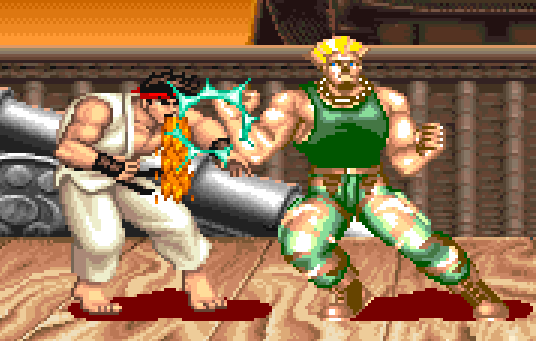by Jed Pressgrove
These notes are based on the SNES version of Street Fighter II Turbo.
I think it’s reasonable to say that Street Fighter II Turbo has more powerful violence than Mortal Kombat II. Granted, this statement wouldn’t have made any sense two decades ago. Mortal Kombat II was a violent revelation in the early 1990s, especially on the SNES. The uncut Mortal Kombat II on SNES satisfied a bloodlust caused by the neutered SNES version of the original Mortal Kombat, which traded the arcade game’s blood for gray sweat. With the prospect of more fatalities and vibrant blood and gore in your home, Mortal Kombat II on the SNES was the baddest of the bad in 1994.
It’s hard for me to feel the same way about Mortal Kombat II in 2014. Since the early 1990s, we have seen countless games with blood and gore. At this point, Mortal Kombat II is just an old game with blood and gore. Its violence has lost meaning. However, I can’t say the same thing about Street Fighter II Turbo’s violence, which retains significant power for a few reasons:
1. The vomiting in Street Fighter II Turbo is relatively unexpected and disgusting.
Gory violence is a main attraction of the Mortal Kombat games. Any hit to the head in Mortal Kombat II causes blood to fly out. You can also expect blood to spew when sharp objects like Kung Lao’s hat are successfully used. Even the finishing moves have a predictability about them — “Finish Him!” is the game giving you permission to perform ultra violence.
In contrast, superior technique is the undisputed focus of Street Fighter II Turbo. That is, we typically don’t play Street Fighter II Turbo because we want to see vomit. Vomiting occurs semi-randomly during battle, which gives it a more surprising effect than Mortal Kombat II’s requisite gore. Sure, we know that a fierce attack, as opposed to a weak or medium attack, is required to cause vomiting in Street Fighter II Turbo, but a fierce attack doesn’t always result in vomiting, unlike the certainty of blood from a kick to the head in Mortal Kombat II.
I often forget about the vomiting in Street Fighter II Turbo. I will never forget about the prevalent and predictable blood in Mortal Kombat II. Part of this memorability goes beyond relative randomness/predictability. If Street Fighter II Turbo had been titled Vomit Fighter II Turbo, I wouldn’t be writing this. “Mortal Kombat” is a title that refuses to allow us to forget about the blood. Not only that, but Mortal Kombat was very influential in the increase of video game blood and gore; thus, Mortal Kombat II’s violence appears normal, even laughable, decades later. In a world where we often expect blood in games, semi-random vomiting during battle becomes a more powerful sign of violence.
2. The aftermath of violence is permanently emphasized in Street Fighter II Turbo.
Before you start a match in Street Fighter II Turbo, you see portraits of the two challengers facing off. After the match is over, you see these portraits again. The portrait of the winner is unchanged (and, of course, the trash talk beneath the portraits comes from the winner), while the portrait of the loser shows the effects of violence. Some of the loss portraits almost suggest death — for example, the life in Sagat’s one good eye appears to be gone.
The loss portraits in Street Fighter II Turbo have retained more power than Mortal Kombat fatalities. Unlike loss portraits, fatalities aren’t about the aftermath or consequences of violence; they simply play into the “We want blood!” motivation behind playing Mortal Kombat in the first place. As Ed Smith suggests, violence loses power when game design encourages killing. In this regard, the designers of Mortal Kombat II tried to satisfy the bloodlust of players by going well beyond the original Mortal Kombat, which only featured one fatality per character. Mortal Kombat II gives each character multiple fatalities, including silly Friendships and Babalities for further cheap entertainment. The problem is that you don’t even get to see these finishing moves if you can’t perform the right button presses. Mortal Kombat II’s insistence on input for fatalities points to another reason why Street Fighter II Turbo’s violence has stood the test of time better: regardless of how you finish off your opponents in Street Fighter II Turbo, you will always see the loss portraits after battle. The loss portraits carry a more certain and permanent sting.
Side note: Street Fighter III took loss portraits to a new disturbing level. Loss portraits in Street Fighter III expanded the focus to the characters’ entire bodies. This approach resulted in material that would receive harsh criticism if released today, such as Elena’s sexualized pose. Interestingly, while Chun-Li was the only Street Fighter II character who cried in her loss portrait, the Street Fighter III loss portraits featured both male and female characters crying, including Dudley, Ken, Necro, Elena, and Ibuki.
3. The Street Fighter series has cleaned itself up.
As new Mortal Kombat games try to top the gore of their predecessors, the Street Fighter series has gotten tamer. Zangief’s infamous biting hold, for example, has not made a comeback in the Street Fighter IV iterations, which have traded the vomiting, occasional blood, and loss portraits of its predecessors for a more exaggerated, cartoonish style of violence. As one watches Ultra Combos from their multiple camera angles in Street Fighter IV, one might find that Street Fighter now has more in common with Looney Tunes than it does with fighting games of the 1990s. If future Street Fighter games continue to refrain from blood and loss portraits, the understated but powerful violence in previous Street Fighters, including Street Fighter II Turbo, will carry more and more weight.
